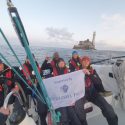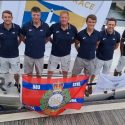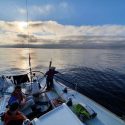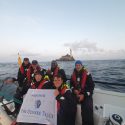In January 2021 the call went out to the Royal Engineers (RE), “Who wants to take part in the RORC Fastnet campaign?” The RE had entered a yacht since the race’s inception in 1925, so it was a fixture on the Sapper’s calendar.
The campaign was open to Regular and Reserve. From the initial call, 55 personnel answered. The campaign manager was appointed, WO2 Jase West (a seasoned Fastneter.) He split the volunteers down into crews of eight to make communication easier and appointed a team leader. Individuals from these crews then volunteered for various tasks such as finance, AT forms, kit, training, sponsorship etc. and fortnightly meetings were held via zoom as the crews came from far and wide.
The campaign was open to non-sailors, so a number of training weekends were arranged from Gosport to familiarise them with the Trojan – a J/109 yacht. Training also covered knots, points of sail, coming alongside and the obligatory man overboard exercise. All members of the team were required to join the REYC (Royal Engineers Yacht Club) and preferably be a member of ASA (Army Sailing Association). All the crew had to pass a military swim test, which proved difficult due to all the swimming baths being closed.
The next hurdle was the RYA courses of which there were three, 1st Aid, Sea Survival and ISAF (International Sailing Federation). These could be completed through the military system for free, the ASA for a nominal fee or privately – not so cheap. All of which relied on people’s availability to the short number of courses on offer.
Once the crews were qualified they were invited to enter the races via the RORC (Royal Ocean Racing Club) SailGate website and upload their RYA qualifications. The qualifying races were classified as sports in terms of military funding, so a minimum flat rate was set for each race weekend to cover charter costs, food, diesel mooring fees, etc. Another criteria for entering the Fastnet is a minimum of 300 RORC qualifying miles in the race yacht. These were achieved by taking part in the Myth of Malham, Morgan Cup, De-Guingand Bowl, St Malo and the Channel race. During these races it was intended to get all 55 personnel on the water and expose them to the rigours of offshore racing.
During these races everyone got exposed to the aims of military AT.
- Leadership. The skipper is ultimately in charge but delegates this down to watch leaders.
- Communication. Having a full spectrum of units, ranks and time to find out what the rest of the Corp is doing. The importance of handing information over on a watch change over eg, bearing, weather, sea state, listening to the VHF radio on channel 16.
- Awareness. Of other boats around you, of your crew, if they are feeling sea sick, are cold etc.
- Discipline. Engine checks, water rationing, ropes coiled, kit put back so the next watch can find it.
- Endurance. A shift pattern of 7 hours On, 3 Hrs Off, 7hrs ON & 4hrs Off, so the shifts rotate. Putting your wet, cold kit back on twice a day.
- Teamwork. Is a given, as the yacht goes nowhere without everyone pulling in the same direction.
- Trust. Trust in your navigator to select the best course, in your instruments during night time sailing, and trust in your safety kit should it go wrong.
For the Fastnet race it was deemed AT by the military and therefore we were governed by a different set of guide lines. One of which was a grant for food which needed to be eaten cold if the sea sate was to bad, or could be eaten hot with the aid of boiling water or put in a gas oven. Needless to say “an Army sails on its stomach”.
The race started on Sunday 8th August 21 with over 400 yachts from around the globe. We had an initial baptism of fire (high waves). All our skills were tested when we had 35 knots of wind over tide while going past the Needles on the Isle of White. This induced a number of the crew to be seasick. Once clear we tacked down to Land’s End where we encountered some light winds and contemplated dropping the anchor. From there we set a North West bearing to the Fastnet light house, the most Southerly point of Ireland.
Once pasted the lighthouse we had a scattering of ashes ceremony for Brigadier Blagden a survivor of the infamous 79 Fastnet.
Highlights included being visited by pods of dolphins, who would circle the yacht and, during the night, would leave a bioluminescent trail. During the night shift we would scan the night sky for satellites and shooting stars, one of which lit the night sky like a distress flare.
On the return leg to Cherbourg we had the delights of some large rolling waves which allowed us to surf down them.
After 850 nautical miles we approached Cherbourg harbour in light winds with the tide against us, only to get within a boat’s length of the finish line and to be pushed back. So we dropped the anchor and waited for the tide to turn and finally finished after 6 days of racing.
The success of the expedition would not have been possible for some of the crew without the financial support of The Ulysses Trust for which the organisers are extremely grateful.
One of the participants of the expedition, Bob Wilkins, commented: “I feel proud to have been part of such an inclusive Fastnet campaign that covered a range of ranks, ethnic backgrounds and genders, and the opportunity as a 170 Reservist to skipper a mixed crew of Regulars and Reserves for the Fastnet race.
“As a Fijian my first job was on a fishing boat, I left home to join the British Army but my love of the sea never left me, and this expedition has made me want to further my sailing qualifications.”
FUN FACT: Throughout the competition progress could be tracked via the internet. All the yachts carry a number of safety features which allow them to compete in the RORC races. One of which is a yellow brick, which is a GPS tracker that sends a signal to a satellite and allows other members of your family or unit to track your progress via the “yellow brick” app.




